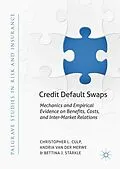This book, unique in its composition, reviews the academic empirical literature on how CDSs actually work in practice, including during distressed times of market crises. It also discusses the mechanics of single-name and index CDSs, the theoretical costs and benefits of CDSs, as well as comprehensively summarizes the empirical evidence on important aspects of these instruments of risk transfer. Full-time academics, researchers at financial institutions, and students will benefit from the dispassionate and comprehensive summary of the academic literature; they can read this book instead of identifying, collecting, and reading the hundreds of academic articles on the important subject of credit risk transfer using derivatives and benefit from the synthesis of the literature provided.
Autorentext
Christopher L. Culp, Ph.D., is a Research Fellow at the Johns Hopkins Institute for Applied Economics, Global Health, and the Study of Business Enterprise, an Adjunct Professor at both the Swiss Finance Institute and Universität Bern, a Senior Affiliate with Compass Lexecon, and Managing Director of Financial Economics Consulting, Inc.
Andria van der Merwe, Ph.D., is a Senior Vice President at Compass Lexecon and a Research Fellow at the Johns Hopkins Institute for Applied Economics, Global Health, and the Study of Business Enterprise.
Bettina St?rkle, M.Sc., is an Economist with Compass Lexecon.
Inhalt
Part I: The CDS Market and Product Mechanics
Chapter 1: Overview of CDS Products and Market Activity
A......... Primary CDS Product Types
1......... Single-Name CDSs
2......... Multi-Name CDSs3......... Asset-Backed CDSs
B......... Aggregate Market Activity
1......... CDS Notional Amounts Outstanding
2......... CDS Trading Activity
References for Chapter 1End Notes for Chapter 1
Chapter 2: Single-Name CDSs
A......... Standard Single-Name CDS Terms and Conventions
1......... Underlying Reference Name
2......... Maturity/Tenor
3......... Coupon/Spread/Premium4......... Credit Events
5......... Settlement Methods
6......... Deliverable Obligations for Single-Name CDSs with Physical or Auction Settlement
B......... Selected Credit Event Determinations
1......... The Argentine Republic (2001)2......... The Hellenic Republic (2012)
3......... Noble Group Ltd. (2017)
4......... Blackstone-Hovnanian (2017-2018)
References for Chapter 2
End Notes for Chapter 2
Chapter 3: Loan-Only CDSs
A......... The Syndicated Leveraged Loan Market
1......... Syndication and Loan Facilities
2......... The Commoditization of the Leveraged Loan Market
B......... Distinctions between LCDSs and CDSs1......... Triggering Credit Events
2......... Coupon/Spread
3......... Deliverable Obligations and Settlement Methods
4......... Early Terminations and Bullet LCDSs
References for Chapter 3End Notes for Chapter 3
Chapter 4: Multi-Name and Index CDSs
A......... Portfolio and Basket Multi-Name CDSs
1......... Portfolio CDSs
2......... Nth-to-Default Basket CDSs
3......... Excess-of-Loss Basket CDSsB......... Index CDSs
1......... Underlying Reference Portfolios
2......... Index Series and Roll Dates
3......... Pricing and Settlement
C......... Tranched Index CDSs
References for Chapter 4
End Notes for Chapter 4
Chapter 5: Asset-Backed CDSs
A......... Structured Finance and ABSs
1......... Special Purpose Entities
2......... Types of Securitizations
B......... Typical ABSs1......... RMBSs and Home Equity Loan-Backed ABSs2......... CDOs
C......... Asset-Backed CDSs Under the 2003 Definitions
1......... SPE Issuers and Credit Events Under the 2003 Definitions
2......... Complications Arising from ABS Structures
D......... The ISDA PAUG Template1......... ABCDSs2......... CDSs on CDO Tranches
References for Chapter 5
End Notes for Chapter 5
Chapter 6: CDS Execution and Clearing Mechanisms
A......... CDS Clearing
1......... U.S.
2......... E.U.
3......... Market Activity
B......... CDS Trade Execution
1......... U.S.
2......... E.U.3......... Market Activity
References for Chapter 6
End Notes for Chapter 6
Part II: Potential Benefits and Costs of CDSsChapter 7: Potential Benefits of CDSs
A......... Credit Risk Transfer
1......... Realized Default Risk
2......... Mark-to-Market RiskB......... Increased Supply of Loanable Funds
C......... Synthetic Bond Investments
D......... Price Discovery and Information Aggregation
References for Chapter 7
End Notes for Chapter 7
Chapter 8: Potential Costs of CDSs
A......... Increased Risk-Taking and Diminished Monitoring by Banks
B......... Empty Creditors, Negative Economic Interests, and Strategic Defaults<...
